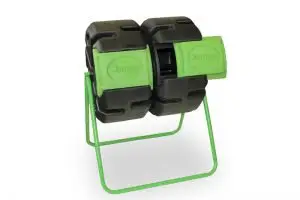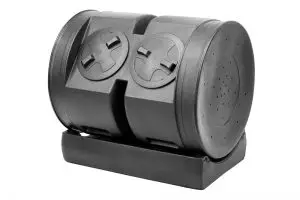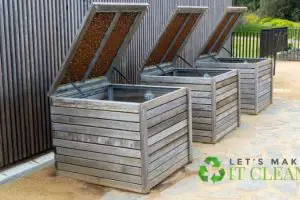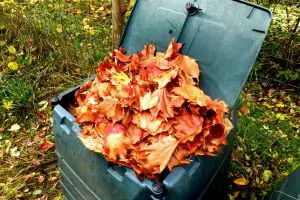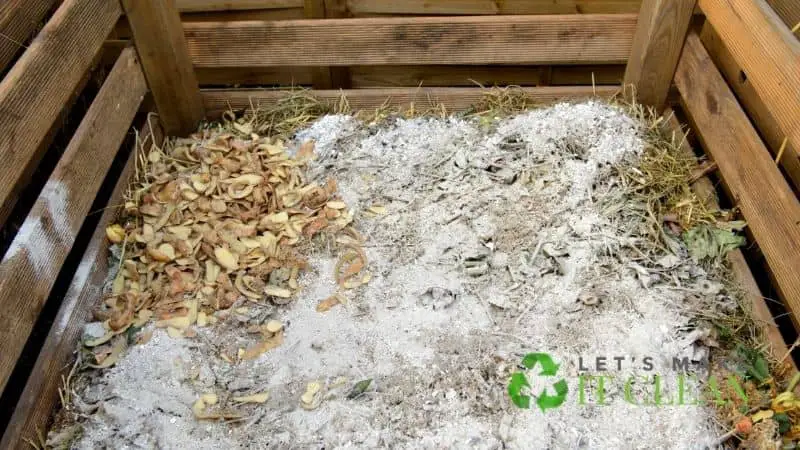Have you ever gotten to the point where you have to choose between a compost bin and a tumbler? Making this decision can be challenging due to the wide range of benefits from either composting system.

However, there are differences in the way each system works, creating a bridge between their finished compost.
Quick Navigation
Now, to help you decide which composting system works better for you, we have invested our time in in-depth research. In this article, we will avail all the information to you.
So, read through this resource and figure out which composter serves you best. Let’s dive right in!
Compost Bin vs Tumbler
Compost bins and compost tumblers are helping farmers improve the fertility of their soils. When deciding which composter to use to improve the fertility of your soil, it would help if you consider the amount of time you have.
Distinguishing Factor
The ultimate distinguishing factor between compost bins and compost tumblers is the time they take in composting.
Compost bins demand more time due to their stationary position. On the other hand, a gardener can rotate a tumbler to allow the compost pile to get even heat for decomposition.
How a Compost Bin Works
The bin composting system requires you to construct, or buy bins that are closed on the top and sides.
Additionally, the bottom side of the bin must get connected to the garden soil directly. This means that you must make sure the bottom side is not covered.

Air and moisture are the two most vital conditions that a bin composter must-have for effective composting of waste material.
Place the compost bins partially under a shade to maintain a favorable moisture level for aerobic organisms’ optimum performance.
Covered Compost Bin
Having all the sides and top of your bin closed will help keep off rodents. Similarly, the enclosure will raise the bin’s temperature for aerobic organisms to increase the composting speed.
The trade-off of this efficiency is the composting time spent to acquire a finished compost pile. With a well-built bin, you will need just a few months to produce compost that is ready for garden use.
Who Can Use Compost Bins?
The compost bin system does not favor all types of farmers. However, some get maximum benefits from building a bin system and composting their waste in it.
If your yard has limited space, you should consider building a compost bin. The bin does not only reduce the hassle of looking for composting space but also saves the cost of buying animal manure.
Also, if you are a gardener who is new to the world or compost manure production, bins will serve you well. With compost bins, you can invest your time in over farm activities as your compost bins produce finished compost for you. You also don’t require to put much effort into composting.
Farmers with neat lifestyle preferences have the advantage of using composter bins. Due to the minimum turning needs, you will not soil your backyard.
Using a Compost Bin
When you want to start the composting process, gather all the kitchen scraps, vegetable matter, grass clippings, and add them to your bin. The composting material takes quite a bit of time to get ready.
You will need to wait for about a month before turning in the composting material.
Once you are contented that the composting process is is to your satisfaction, you can remove the compost heap. Removing this pile requires people to use a pitchfork or shovel to reach the material at the bottom of the pile.
Lifting the bin off the compost pile is also a great way of removing finished compost. The material that is not ready for garden use should be returned for further decomposition.
Using a Tumbler Composting System
Tumblers are upgraded compost bins meaning they deliver better results than compost bins. The design of tumblers makes it easier to turn the composting material.
Moreover, this easier-to-use design accelerates the decomposing process of becoming a gardening pal.

Tumblers have instruction manus that help the farmers utilize the tumbler giving maximum benefits in short durations.
Nitrogen and Oxygen
The maximum benefits of compost tumblers are achieved with a balanced nitrogen ratio without limiting the amount of oxygen in the tumbling composter.
Balanced nitrogen and oxygen ratio facilitates a favorable moisture level that requires constant watering. However, the most productive way of getting a productive moisture level is having partial tumbler exposure to the sun.
Who Is Composting Tumblers Best For?
Enthusiastic gardeners have the perfect comping system if they use tumblers. The vigorous character will help you realize better profits from the easy turning of the pile.
Additionally, if you have more food scraps and garden waste for composting, a plastic tumbler is your composting solution. With its ease of use, your power to handle more composting material is heightened.
If you prefer spending more money to get a faster decomposing process, you can invest in tumblers. The tumblers are a little bit expensive, but the processing speed is worth the cost.
Making Tumbling Composters
Avid people have the upper hand in making tumblers at home. You will only need to put in a little more effort with the right material. Take a quick trip to the market and buy a plastic container. Make sure the container can fit in your yard.
A quick trip to the market will ensure you make compost tumblers at home all by yourself. But it will require much more effort, materials, and work than if you were to make compost bins.
The quality of the container determines how long your tumbler will conveniently serve your compost pile needs.
How to Use Tumblers
The system of a tumbler is amazingly easy to use. Therefore, whenever you add new material to this state-of-the-art equipment, you will need to turn the pile at least once every day.
It would be best if you decided to avoid turning the pile more than once per day.
Maintain the high temperature in your tumblers to keep having a faster decomposing speed. Meet the temperature required by having the tumbler partially exposed to the sun. Also, avoid more than necessary turning.
What’s the Difference Between Compost Bin and Compost Tumblers?

Tumbler and compost bins are different in several ways. Below are some of the factors to consider when deciding which one is better:
Pest Control
When it comes to pest control, both the compost bin and the tumbler do a good job. A compost bin prevents dogs and raccoons from accessing the compost, but when it comes to rodents, they can find their way in through the base as the area is warm and there is food there.
If you want 100% pest-free to go for the compost tumbler. It is completely sealed so there is no way pests can access the compost. Apart from that the area around the compost tumbler is ever clean such that you can even empty the tumbler when you are barefooted.
Odor Control
A compost bin and a tumbler help in controlling the compost odor but each has its degree of control. When the lid of both the compost bin and compost tumbler are closed there is no odor coming from the compost but once you open there will be a distinct smell, but it’s not unpleasant.
Cost
When it comes to price, the compost tumbler is more expensive than the compost bins. In a rough estimation, the compost tumbler is 30% expensive more than the compost bin. This is because when it comes to durability, the compost tumbler will serve for a longer period than the compost bins.
When choosing a composter, go for the one with fewer moving parts; an example is a rod, and gear that is used in spinning, unlike the one in which you use a shovel or the pitchfork and end up breaking your composter.
When it has fewer moving parts, it will serve you for more years and save you from spending more money purchasing in between the year. So, even if it cost some extra coins, it is all worth it in the long run.
Composting Time
Everyone wants a composter that will take a short time and give you that rich compost. A compost tumbler helps in speeding the decomposing process as it provides a better environment for aeration and retains heat which helps in the process.
In some cases, people have performed a side-to-side experiment between the compost tumble and the bins to confirm which will take a short time. The results were the tumbler took half the time the bin took to decompose the materials.
But having in mind the bins carry more compost material after the composting process is over, it will have more compost compared to the composting tumbler.
Footprint
They both occupy almost the same space as 4-6sq.ft. Most bins are designed with open bottoms, and hence you can’t move them from one point to another. But still, there are several bins with a wheel which make it convenient to move the finished compost to the garden.
Also, the tumblers are designed to be stationary, but all their sides, the bottom, and the top are covered. But still, there are movable tumblers which when the decomposing process is done you move the compost direct to the garden.
In case your tumbler doesn’t have this feature, a wheelbarrow for moving the compost will work just fine.
Capacity
When it comes to capacity, compost bins carry the day. It carries around 2-3 more compost compared to the tumbler. In most cases, compost bins hold around 7-20 cubic feet of the decomposing material, but it’s good to note the capacity varies with models.
For a compost tumbler, it holds from 4 to 15 cubic feet. The reason the compost tumbler has less capacity is it is hard to move and spin large capacity, and for that reason, they have to keep it to the minimum.
Also, there are models of compost tumblers with a high capacity of 14.2cu ft but still is easy to move them as they are horizontally mounted on their axis. An example of this compost tumbler is the three Jora models.
Durability
When it comes to durability, the compost tumbler is more durable than the bin as seen before. One reason they are durable is they are constructed with strong materials as they have to hold all the weight of the compost.
When buying a tumbler ensure you inspect the legs to ensure they are strong and they can hold the compost weight without breaking. Apart from that, you should also check the axis connecting in the center as it needs to be strong too.
For compost bins, they are made using thinner plastic as they don’t have to hold the weight since they have an open bottom. The thin plastic gets brittle when exposed to cold weather and the sunlight too. Ensure you are careful with the lid when emptying the bin as the lid can crack or chip.
Functionality
For a compost bin, you have to mix the composting materials manually using the pitchfork, and having in mind it carries up to 20cu ft, it becomes hard to access the compost from all corners. At some point, there is the risk of damaging the bin with the shovel as you turn.
When you don’t turn the compost well, this means there will be less aeration, and hence the decomposing process will be longer. The process can take from two to three months depending on the weather of your area and what season it is.
On the other hand, the compost tumbler is designed in a way that turning the compost is easy as all you have to do is spin the drum every week. This is the feature that makes tumblers stand out among other composters as it contributes to fast decomposing.
Apart from that the fact that compost tumbler is sealed helps in developing heat which helps the microbes in their activities and speeds up the process. For compost tumblers, it takes around six to eight weeks to get finished compost.
It develops more heat which further speeds the decomposition of composting materials. With our compost tumbler, we cycle through batches in about 6 – 8 weeks.
Video: Tumbling Composters vs. Regular Bins
Final Verdict
Hopefully, this resource has provided more information than other articles or any blog out there. You can decide which composter to use by using the guidelines above.
The amount of time on your hands is a key determinant of the composting method you should use.
Similarly, the size of the waste pile in your home will affect your decision-making process. More waste demands the use of a tumbler. On the other hand, farmers with less waste can comfortably use a compost system.

